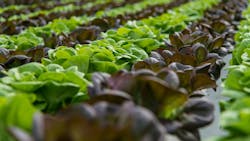In the United States, the Food and Agriculture (FA) sector is classified as one of 16 critical infrastructure sectors, putting the importance of FA alongside the Energy Sector and Information Technology, to name a few.
As the COVID-19 pandemic emerged and supply chains underwent disruptions, we saw what food shortages could look like on a greater scale. People visited grocery stores and found themselves unable to find their regular items—from toiletries to fresh produce to snacks. This disruption contributed to the FA sector reemerging to the forefront of the public conversation, as has concern around ensuring its security.
Feeding the global population, which is predicted to reach 8 billion by 2050, is mission-critical. If people are unable to put food on the table, the impact will have a ripple effect, negatively impacting the economy, public health, national security, and beyond.
This summer, I attended a Food and Drug Association Summit held by the White House that focused on examining risks to the FA sector and how to prioritize proactive, national protections focused on addressing food security.
The agriculture industry faces a multitude of pressing challenges that threaten its viability and long-term sustainability. Now is the time to take action and ensure food security for the populations of tomorrow.
The State of the Industry
Labor shortages are an especially critical issue in agriculture, as an aging workforce and a lack of skills make it difficult for farmers to find the necessary manpower to operate their farms. This shortage has led to increased competition for workers and higher labor costs, placing a strain on profitability.
The industry is also grappling with rising input costs. Rising fertilizer and fuel prices, coupled with supply chain disruptions, have significantly increased expenses in agricultural production. This cost inflation has eroded farmers' profit margins, making it difficult for them to sustain operations.
Moreover, climate change poses perhaps the greatest threat to the agriculture industry. Shifting weather patterns—more frequent and severe droughts, floods, and heatwaves—have the potential to disrupt or decimate crop yields and livestock production.
This combination of labor shortages, higher input costs, and climate change has created an environment of uncertainty and vulnerability for farmers. Without effective interventions and supportive policies, the agriculture industry will struggle to meet the growing demand for food.
Technology offers a path forward: with technological advancements from farm machinery to autonomous applications, farmers are able to do more with less. But, as technology expands to fill gaps, the threat landscape expands, and critical data and machinery are put at risk. As the agriculture sector continues to face challenges, it’s imperative to practice proactive risk mitigation and look to cybersecurity leaders for guidance on up-to-date security protocols.
How AgTech Mitigates Challenges
Technology has revolutionized agriculture. Today's farmers are running vast business operations that require a combination of traditional farming practices and cutting-edge technologies.
Two of the most significant technological advancements in agriculture are the use of artificial intelligence (AI) and computer vision. With this technology at hand, farmers are able to automate tasks such as tilling a field to prepare the soil for planting, crop monitoring, pest control, and harvesting.
Using data from the cloud, like satellite imagery, stored weather patterns, and soil conditions, farmers now have real-time insight into the health of their crops at their fingertips. With this information, farmers can make informed decisions about irrigation, fertilization, and pest management, leading to increased crop yields and reduced costs.
Another transformative technology in agriculture is vehicle technology. Farmers can now program and use autonomous vehicles that can operate without human intervention. These machines are equipped with sensors, cameras, and GPS systems (that are even more advanced than self-driving cars) that enable them to navigate fields and perform tasks with the utmost precision.
Autonomous vehicles can operate independently within prescriptions set by farmers, which increases efficiency and fills labor gaps. By operating through a variety of conditions on command, autonomous vehicles can also help farmers mitigate challenges posed by climate change, such as extreme weather events and unpredictable growing conditions.
Farmers also benefit from various other technological advancements, such as smart irrigation systems, precision agriculture tools, and remote sensing technologies. These technologies help farmers optimize water usage and monitor crop health, ultimately allowing them to make better decisions about planting, harvesting, and other farming operations based on trends from past data.
The Expanded Threat Surface in Agriculture
Though technology has offered farmers solutions for some of their biggest challenges, increased reliance on technology in modern agriculture has created a new set of risks for farmers and our food system. As more farm machinery uses technology and digital interfaces, the attack surface on farms expands, encompassing sensors and IoT systems used for farmland management.
Attacks on our food system can take many forms. In 2023, the food and agriculture sector dealt with 167 ransomware attacks, making it the seventh most targeted sector out of 11 critical sectors monitored by the Food and Ag-ISAC and IT-ISAC. A ransomware attack at a critical time during farming, such as planting or harvesting, could result in a region not being able to produce food, or it could lead to a chain of delays that could have a significant impact on availability, prices, and access to fresh, nutritious food for consumers.
Data breaches also pose a significant threat to the FA sector. Sensitive data such as crop yields, livestock records, and financial information could be compromised in a data breach, leading to economic losses, reputational damage, and potential food safety risks.
To mitigate these risks, farmers and agricultural organizations must prioritize cybersecurity measures. This starts with implementing robust security protocols, regularly updating software and firmware, and educating employees about cybersecurity best practices.
Tips for Proactive Risk Mitigation
Cybersecurity leaders in agtech have a daunting task ahead of them to protect their organizations' data from an ever-increasing number of threats. To do this, they must take a proactive approach to cybersecurity.
Rather than waiting for a cyberattack to reveal potential vulnerabilities, leaders must actively engage in penetration testing, tabletops, and red-teaming to secure their systems. By addressing vulnerabilities before they are exploited, leaders can significantly reduce the risk of a successful cyberattack.
Cyber leaders should also create comprehensive incident response plans, outlining the steps that will be taken in the event of a cyberattack or security breach. The moments after an attack are not just about recovering data; they're about minimizing damage and getting back to business as quickly as possible. A well-developed incident response plan can help leaders do just that and give peace of mind to leaders in the event of an attack.
Technology has had a profound impact on the FA sector, making it more efficient, productive, and sustainable. As technology continues to evolve, farmers will have access to even more powerful tools and resources that will further revolutionize the way they grow food and feed the world.
But, with new technology, come new threats. Farmers and cyber leaders need to take proactive measures to ensure the safety of their farm data and the future of food security. Together, they play a vital role in securely feeding the world's growing population and keeping food on people's tables.
About the Author

Mike Lexa
Mike Lexa is the CISO and Global VP of IT Infrastructure at CNH, where big farm machinery meets cutting-edge tech. With over 20 years of experience, Mike has built robust enterprise programs for global organizations across industries such as agriculture, retail, manufacturing, and high-tech. Before joining CNH, he held several leadership positions with Fortune 500 companies, including over a decade as a cybersecurity executive at Target. His extensive experience offers a comprehensive understanding of cybersecurity challenges and solutions, demonstrating adaptability and effectiveness across diverse cybersecurity landscapes. Passionate about fostering future cyber talent, Mike actively contributes to multiple boards, advises cybersecurity startups, and organizes industry events that promote collaboration and innovation.
